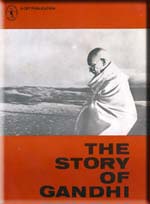
P.O. SEVAGRAM, DIST.WARDHA 442102, MS, INDIA. Phone: 91-7152-284753
FOUNDED BY MAHATMA GANDHI IN 1936
The Story of Gandhi

THE STORY OF GANDHI
Written by : Rajkumari Shanker
Table of Contents
- Birth And Childhood
- Preparation for England
- In England
- Back In India
- In South Africa
- In India
- Back In South Africa
- Indian National Congress
- In South Africa Again
- Assault
- Tolstoy Farm
- Returned To India
- Establishment of Satyagraha Ashram
- Benaras Speech
- Champaran Satyagraha
- Ahmedabad Mill-Workers Satyagraha
- Rowlatt Act
- Jallianwalla Bagh Massacre
- In Prison
- Salt Satyagraha
- Sevagram
- Cabinet Mission Plan
- Quit India
- He Ram!!!
About This Book
Written by : Rajkumari Shanker
First Edition :1969
I.S.B.N :81-7011-064-5
Published by :Children's Book Trust,
Nehru House, 4
Bahadur Shah Zafar Marg,
New Delhi 110 002,
India.
© CBT, 1969
Download
Chapter-16: Ahmedabad Mill-Workers Satyagraha
Gandhi hurried back to Ahmedabad.
Before taking up the Labour dispute Gandhi wanted to move his ashrama. The Satyagraha Ashrama was in a village near Ahmedabad, but the surroundings were not clean and plague had broken out. It had spread there from Ahmedabad.
A rich merchant of Ahmedabad, who was closely associated with the ashrama, volunteered to procure a suitable piece of land. Gandhi went about with him looking for land and at last they chose a place on the bank of the Sabarmati Ashrama was started.
In Ahmedabad there were many textile mills. Prices had gone up and the mill workers were demanding higher wages. The mill owners would not agree. Gandhi sympathized with the workers and took up their cause. He launched a struggle and resorted to peaceful resistance. The workers proudly followed Gandhi and pledged their full support to him. They paraded the streets with large banners, and said they would not go back to work until a settlement had been reached.
Days passed. The mill owners were adamant. The strikers were getting impatient for they were faced with starvation. Their discipline became weak. Gandhi feared that some workers would break their pledge and go back to work. That would be a great moral defeat.
One morning he called the workers and said, ‘Unless the strikers rally and continue the strike till a settlement is reached. I will not touch any food.’
The workers were shocked.
‘Not you, but we shall fast,’ they said. ‘Please forgive us for our lapse; we shall remain faithful to our pledge.’
Gandhi did not want anybody else to fast. His fast was not against the mill owners, but against the lack of co-ordination and unity among the workers. The fast lasted only for three days. It influenced the mill owners so much that they came to an agreement with the workers.
Hardly was the mill workers’ strike over, when Gandhi had to plunge into the Kheda Satyagraha struggle.
The Kheda district of Gujarat was on the verge of famine owing to failure of the crops. The yield had been so low that the cultivators, especially the poorer section, were unable to pay the revenue. But the government insisted that the yield had not been so bad and that the cultivators should pay the tax. Gandhi saw the justice of the cause of the cultivators and advised them to offer Satyagraha by not paying their taxes.
Many leaders, like Vallabhbhai Patel, Shankarlal Banker, Mahadev Desai and others, took an active part in this struggle. The campaign came to an unexpected end. There had been signs that it might fizzle out, but after four months’ struggle there came an honourable settlement. The Government said that if well-to-do cultivators paid up the poorer section would be granted suspension. This was agreed to and the campaign ended.
The Kheda Satyagraha marked the beginning of an awakening among the peasants of Gujarat, the beginning of their true political education. In addition it gave to the educated public workers the chance to establish contact with the actual life of the peasants